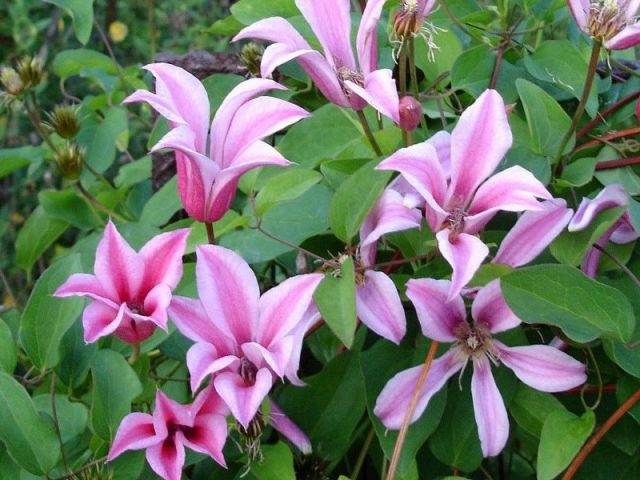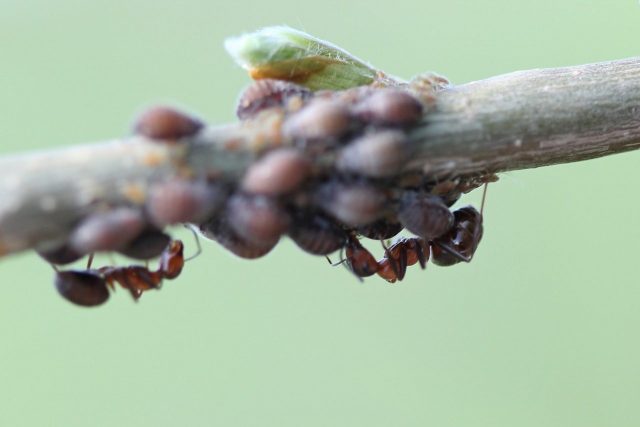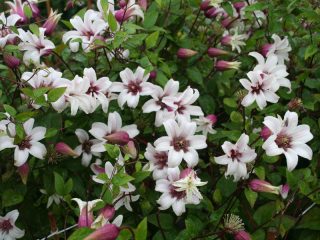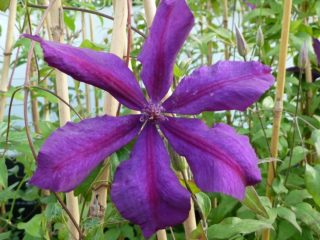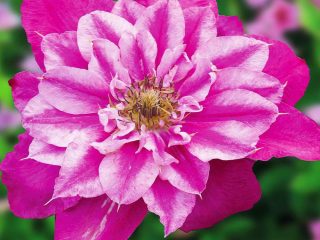Content
Clematis Duchess of Albany is an exotic liana. The historical homeland of this perennial plant is the subtropics. Despite this, the liana feels good in the temperate climate of Russia. Gardeners liked Duchess of Albany due to the original shape of the flowers.
Description of clematis Dutches of Albany
Daches of Albani is a shrub reaching a height of 2-3 m. Clematis has tulip-shaped flowers, the diameter of which is up to 8 cm. The bud consists of 4-6 petals. They are painted soft pink. Dark pink or crimson stripes are visible in the central part of each petal. The upper part of the petals is curved up and to the sides. Their length is 4-6 cm. Pink anthers are located in the middle of the flower. Clematis does not have a distinct aroma. The flowering period of the vine is from July to September. It forms buds on newly grown shoots. After the flowering period, decorative fruits remain on the bush. The leaves are simple, dark green. Use vertical cultivation of clematis. Can grow independently up other trees and shrubs. Plantings are placed near gazebos and along fences.
Clematis pruning group Duchess of Albany
Clematis botanical Duches of Albany pink tulip-shaped belongs to the shrubs of the 3rd pruning group. Experienced gardeners leave the height of stumps from 20 to 30 cm. It is good if each of them has 2 or 3 buds.
Planting and caring for clematis Dutches of Albany
Dutches of Albany loves sunny, well-lit places. Shrubs do not grow in low areas where groundwater is close. Prefers fertile, slightly alkaline soils.
To place the seedling, Duchess of Albany prepares a planting hole. It should not be very wide, but deep enough, since the root system grows downwards. A suitable depth is up to 70 cm, width is 60 cm. Drainage is laid at the bottom of the prepared hole:
- gravel;
- broken brick;
- other material.
This layer should occupy 20 cm. The excavated soil is mixed with humus. For one seedling - one bucket of humus. Add 2 tablespoons of superphosphate and a little ash. The prepared soil is poured into the hole with a mound, and the roots of the seedling are spread on it. Carefully pour soil up to the edge of the hole. Clematis is watered. The surface of the ground around the plant is mulched.
Further care for clematis consists of weeding, watering in dry times, and fertilizing. The shrub loves both nitrogen and potassium-phosphorus fertilizers. It is better to feed with nitrogen in the first half of the season. Use urea - 1 tbsp. l. on a bucket of water. Potassium and phosphorus are added in the second half of the season. These two elements help to better endure the cold period. At the beginning of autumn at 1 m 2 add 200 g of bone meal. Fresh manure cannot be used for feeding.
Preparing for winter
Clematis Dutches of Albany is frost-resistant.It can withstand temperatures down to -20 degrees. It needs to be prepared for the cold period:
- Pruning of shoots is carried out a month before the onset of cold weather.
- The shoots remaining after pruning are spudded. It is enough to roll over them a hill of humus 30 cm high. The material used for hilling must be loose.
- You can cover the stumps with spruce branches and make a frame out of a wooden box.
- To repel rodents, pesticides are placed under the shelter. If they are absent, the shoots may be eaten or gnawed.
In spring, clematis opens gradually. It is important to prevent overheating. First, remove one layer of cover and wait several days. Then the next layer is removed. So, clematis will gradually get used to environmental conditions.
Cover young clematis seedlings. An adult plant may not need to be covered during snowy winters. It is enough to pour a bucket of humus or peat onto the cut parts of the shoots.
In winters with little snow and low temperatures, shelter is necessary.
Reproduction
Duchess of Albany is propagated in different ways:
- seeds;
- cuttings;
- dividing the bush;
- layering.
Each of these methods is simple. By following certain rules, after a short time you can get several bushes of the plant you like.
Propagation by seeds takes a long time. Buy them in a specialized store.
Propagation by cuttings is carried out in the spring before the formation of buds:
- The shoot is divided into parts with two internodes.
- The lower cut is made at an angle of 45 degrees and treated with any means that promotes root formation. The bottom sheet is removed.
- The cuttings are placed in a cup of fertile soil or in a garden bed. The soil is sprinkled up to the second node. Treated with a growth stimulator.
- If the place is sunny, shade the cuttings. Needs constant watering.
- After a month they form roots. By winter, the cuttings are covered.
- Planting in a permanent place is carried out in the spring.
The Dutches of Albany bush can be divided. For this method of propagation, a plant aged from 5 to 7 years is used:
- They dig up the bush, separate the sprout, and plant it in a new place. You can dig up the bush completely and carefully divide it.
- If the roots are very large, they are shortened by a quarter, and the cut points are treated with a solution of potassium permanganate.
- The disturbed bush is fed with fertilizer. So, clematis is divided in spring and autumn.
Reproduction by layering begins in May or June:
- Make a deep furrow under the bush.
- The shoot is placed in it and covered with earth. The leaves are left on the surface.
- For reliability, the knots of the whip are pinned to the soil in any way.
- During the summer, water and feed clematis.
- By the end of the season, rooting occurs at the nodes. Do not touch the rooted shoot until spring or even next autumn. Shelter for the winter.
- In the first year after transplanting, the buds are removed so that the Dutches of Albany seedling grows strong.
Diseases and pests
Clematis Dutches of Albany is very resistant to damage and pests. He practically never gets sick. To protect the plant, it is always better to take preventive measures. When purchasing a seedling, you should pay attention to its condition:
- There should be no thickening on the roots. They must be healthy and whole.
- There should be no stains or other damage on the leaves.
More often, clematis is affected by aphids.Various means are used to combat it:
- Destroy the pest manually or wash it off with a stream of water. The method is suitable if there are few aphids.
- A folk remedy is used to spray plants. Prepare a solution from 2 tbsp. water, 2 tsp. soap and 1 tbsp. l. vegetable oil. Infusions of garlic, onion peels, hot pepper, and horseradish are also used.
- Treated with insecticides. For this purpose, Fitoverm is used - it is biologically based.
Conclusion
Clematis Dutches of Albany is an unusual vine. Does not require much care, is not affected by pests, and tolerates cold periods well. It has some advantages. Thanks to these qualities, gardeners are happy to grow a plant of this variety.
